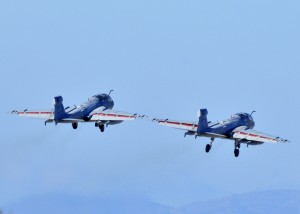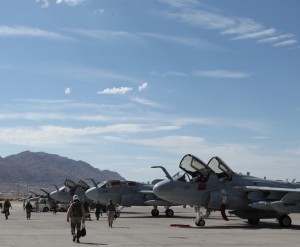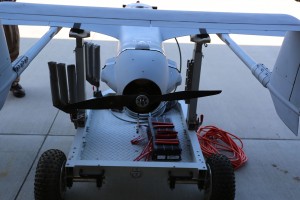2015-06-23 By Robbin Laird and Murielle Delaporte
During our visit to 2nd MAW on May 18, 2015, we had a chance to talk with two members of VMAQ-3, an electronic warfare squadron flying EA-6B Prowler jets.
It is part of Marine Aircraft Group 14 under the 2nd MAW.
We interviewed two members of the squadron who recently joined the EW world.
With the first Prowler pilots being trained this summer at Beaufort for the F-35B, a transition is already underway.
The Prowler is due to be retired in 2019 and will be replaced by a wide-ranging focus on EW throughout the MAGTF.
One asset that will play a role will clearly be the F-35, which is in Ed Timperlake’s words, a “tron warfare aircraft.”
And Major Summa, the XO of the Green Knights, who is taking over as the Warlords CO highlighted how the F-35 affected the EW approach:
Question: Obviously your pilots need to be trained to combine the air-to-air and CAS capabilities and to use the new organic tools sets as well?
Major Summa: It does.
Now we’re going to have a pilot that’s versed in doing CAS, if he needs to use the electromagnetic spectrum or exploit it to accomplish his mission, he’ll be educated and have the equipment to do so.
If he needs to use it in the air-to-air arena to exploit it, to accomplish his mission, he’ll have the training and the equipment needed to use it as well.
In the current situation, I would deploy a Prowler to work with my legacy fighters.

A pair of EA-6B Prowlers, assigned to Marine Tactical Electronic Warfare Squadron (VMAQ) 3, take off following a transient stopover. The Moon Dogs of VMAQ 3 are based at Marine Corps Air Station Cherry Point, North Carolina with a mission of supporting the Marine Air-Ground Task Force (MAGTF) commander by conducting airborne electronic warfare, day or night, under all weather conditions, during expeditionary, joint, or combined operations. U.S. Navy photo by Paul Farley
The Prowler would have to be sortied and would operate only for a period of time and in a specific operational area.
With the low observability of the F-35 combined with the organic EW capability of the aircraft, the aircraft expands my capabilities for both air-to-air and CAS.
Clearly, unmanned aircraft or remotely piloted vehicles will be added to the mix as well.
Currently, the USMC Blackjacks carry payloads to contribute to EW and over time the UAV element will enhance its role as well.
In an article by Joshua Stewart in Marine Corps Times published on January 29, 2015, the shift in roles of Marines in supporting EW was discussed.
As the EA-6B Prowler flies into retirement and the Corps takes a new approach to electronic warfare, some Marines who spent their careers in the radar-jamming aircraft will be transferred to other military occupation specialties, and many will work with unmanned aircraft.
About 10 percent of Marines in the 7588 electronic warfare officer MOS will become 7315 unmanned aircraft systems officers. Concurrently, the Corps is changing the duties of the 7315 MOS.
“The new 7315 MOS will provide us with a cadre of better-trained and more versatile [unmanned aircraft systems] officers capable of serving in a variety of operational roles in support of Marine Corps doctrine,” said Maj. Paul Greenberg, a Marine spokesman at the Pentagon.
Most of the transitioning electronic warfare Marines will be company-grade officers with a primary 7588 MOS, Greenberg said. Other electronic warfare officers will stay in that MOS until they leave the service, and will serve in B-billets, he said.
The electronic warfare community’s transition is one facet of the Corps’ new approach to controlling the electromagnetic spectrum in battle, and the service’s new philosophy is more complex than merely rolling dozens of Marines from a niche community into a new MOS.
Currently, Prowlers are the service’s electronic warfare workhorse, but in the future, a variety of platforms — including unmanned systems, rotary aircraft and ground vehicles — will also be a part of this warfare domain. It amounts to a Corps-wide makeover of electronic warfare in which manipulating and monitoring the electromagnetic spectrum is a more integral part of every aspect of combat.
The mission of the squadron VMAQ-3 is identified as follows:
Support the Marine Air-Ground Task Force (MAGTF) commander by conducting airborne electronic warfare, day or night, under all weather conditions during Expeditionary, Joint, or Combined operations.
Captain Casey Jacobs, Prowler pilot, has been doing this job for over three years. This is his first fleet squadron.
Captain Colton Browser is an electronic weapons officer and he been in the squadron for just under three years as this is his first tour as well.
One of the challenges which the Prowler community has is that it has more in common with other EW communities in the Air Force and Navy than it does with many Marines.
This will change as EW becomes a ubiquitous part of USMC operations.
As Captain Jacobs put it: “The feedback we get from Marines is that the plane works in supporting them.
But there is a lack of general understanding of what we do, and the problem lies in that there isn’t a wide understanding of what we do and how we contribute.
We work a lot with the USAF as well.
And as such we are part of general support for the leadership with the Combined Air Operations Center during operations.”

Captain Browser added that the Prowler is understood more by myth than reality.
“We go to airshows and people have understanding based on myths more than realities and, for example, assume that our fuel probe is a laser beam and that sort of thing.”
It is quite different when one goes to the Weapons Tactics and Training Courses at MAWTS where integration of EW within the combat capability of the USMC is a key focus.
As Captain Browser put it: “At WTI there is a clear focus on how to integrate EW into combat operations.
At our most recent WTI, we participated in all of the various air support tasks for the MAGTF, including air to air and close air support.
This is in contrast to our Red Flag experience where we are treated as a specialized asset in the battlespace.”
And with the coming of the F-35, MAWTS is working on how to integrate the plane with its various capabilities into the force, and that includes EW.
Some Prowler pilots will transition to the F-35 community as well.
The members of the squadron noted that there are four Prowler squadrons overall with three of them at Cherry Point with 18 planes per squadron.
The Prowlers are a high demand asset and in constant rotation to combat theaters where they are attached to “different commands for whatever they are needed for.”
The rethink about EW is along the lines of Ed Timperlake’s broader concept of Tron Warfare.
As Captain Browser put it: “We are focused on the entire electromagnetic spectrum, so anything from communication, to RF energy produced by radars etc.
It is a very large spectrum that we need to contain to have combat superiority.
The Prowler has limitations on what we can control within that spectrum, but going forward the USMC approach will be that not just one platform can do everything.
We are going to shape a collaborative approach to achieve spectrum dominance.”
The Marines are blending the various MOSs or Military Operational Specialists in shaping a forward leaning tron warfare approach.

According to the article by Stewart quoted earlier:
The MOS transition process will start as early as October as Prowlers begin to be phased out, Greenberg said. The transition will continue through fiscal 2019 when the aircraft leaves the fleet.
About 80 percent of electronic warfare officer billets are expected to become unmanned aircraft systems officer billets, he said. Other electronic warfare officers are expected to transition to other pilot or naval flight officer MOSs, or switch into intelligence or communication communities.
Greenberg said others will join the Marine Air Ground Task Force Cyberspace and Electronic Warfare Coordination Cell, a unit that will help the Corps develop its cyber and electronic warfare capabilities.
For Captain Jacobs: “The Navy has tended to be more stove-piped than the USMC with regard to EW.
What we have had to do to survive and thrive is to work with the infantry to provide EW directly to them.
They may not understand completely the process but they like the product.
This means that a broader range of MOSs than simply EW ones are looking at cyber and EW and what it contributes to the success of their own combat area of specialized interest.
This is creating a more integrated approach.”
In other words, the mental furniture of various combat specialties is being recast to open the aperture to understand that tron warfare is not a specialty but a constant of combat success.
This has been a consistent theme within Marine aviation since the decision was made to sundown the Prowlers in 2009.
At the time, LtGen Trautman, then Deputy Commandant for Aviation, said:
Employing a manned low density, high demand electronic warfare platform makes absolutely no sense in a world that will be dominated by F-35, unmanned aerial systems, and full digital interoperability among every aircraft and sensor operating within the future battle space.
Electronic warfare aircraft like the Prowler and Growler are, by their nature, self-limiting technologies that are an anachronism of the last century.
We can and must do better.
Editor’s Note: With regard to Tron Warfare, Ed Timperlake has described the subject as follows:
EW is a complex subject with many discreet but also connected elements. Over time all things electronic in the military took on many dimensions. Electronic Counter-measures (ECM) begat Electronic Counter-Counter (ECCM) measures, Command and Control (C&C) has grown to C5ISR. Information war in certain applications created a multi-billion dollar domain called “”cyber.”
Additionally there has to always be considerations of Electro Magnetic Pulse concerns (EMP) and the counter measures of ‘hardening” of electronic components. There are a lot of other EW issues in “tron war,” such as Infer-Red Sensing (IR) and always protecting “signals in space” information being transmitted and trying to jam the bad guys “signals in space.”
Tactically, it has been said on the modern battlefield — air, sea or land — if not done correctly, “you emit and you die.”
EW can include offensive operations to identify an opponent’s emissions in order to and fry spoof or jam their systems.
In successful “tron” war, often-kinetic kill weapons can be fired. The kinetic kill shot is usually a high-speed missile designed to HOJ (home on jam). There is also the ability to emit electronic “kill” or spoofing signals i.e. to emit miss signals to an enemy’s incoming weapon sensors.
A combat certainty is “tron” warfare will grow in importance and will evolve as a critical component of future combat engagements. The issue of all things “EW” or “tron” war is extremely complex because electrical components engage in empowering a nation’s ability to fight and win and covers so many facets of combat.

